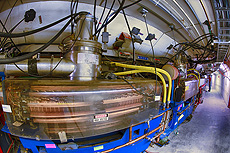Beam returns to the Booster
 |
Last month Fermilab's Booster saw beam for the first time since the accelerator complex shut down last year. Photo: Reidar Hahn |
Fermilab's Accelerator Division has breathed new life into the Booster.
Last month, the Fermilab Booster saw beam circulate through its 468-meter ring for the first time since the laboratory's accelerator complex shut down on April 30, 2012. It's a milestone on the road to the restart of the laboratory's accelerator complex, which is scheduled to take place this summer.
"It was a big relief," said AD Operation Specialist Salah Chaurize. "After that beam went through, you know there's still a lot of work to be done, but you also know you have a good starting point."
Beam's return to the Booster is an important step in ushering in a new era of exploration using high-intensity proton beams at the laboratory. As the second of three major acceleration stages in Fermilab's accelerator complex, the Booster accepts beam from the Linac, boosts it to higher and higher energies, and then passes it on to the much larger Main Injector, which brings the beam up to even higher energies before sending it to various experimental areas.
Fermilab's future scientific programs, such as MicroBooNE, Mu2e and NOvA, require far more intense particle beams than did past experiments. So engineers and technicians have spent the last nine months prepping the Booster to handle the kinds of beams needed for studies at the Intensity Frontier. That meant new equipment, substantial reconfiguration and lots of upgrades.
"The accelerator is over 40 years old, so there's a good portion of it that needs to be maintained and upgraded," said Kent Triplett, Booster Group engineering physicist. "Some of the stuff was really old—you'd have to go out and kick it to make it work."
AD members retooled the water piping system that cooled the Booster's 19 radio-frequency power stations, which propel the beam, and rebuilt its accelerator cavities. They also installed and configured new power amplifiers, power modulators, solid-state drivers and cabling.
With assistance from the Accelerator Physics Center, they also developed the instrumentation needed to operate intense beams. One new crucial component was the notched beam absorber, designed by AD's Vladimir Sidorov and built by PPD technicians Wojciech Blaszynski and Jerry Judd. The absorber removes sections of the beam in a controlled way, allowing the creation of a gap in the circular beam and helping reduce radiation in the tunnel at the time beam is extracted.
After overhauling the Booster configuration, the Booster Group performed final checkouts before turning on beam. Engineers and technicians thoroughly swept the accelerator for potential problems, checking every cable and flipping every switch.
"Only then did we feel confident enough to say, 'Let's try beam,'" Chaurize said.
When they pushed the button, it went off without a hitch.
"It was remarkable that the first pulse of beam that came into Booster circulated," Triplett said. "We were really fortunate and glad it happened on the first try."
Now that Booster beam is up and circulating, the Accelerator Division will spend the next several weeks gradually increasing its intensity and performing beam studies. Soon enough, it will be ready for delivery to the Main Injector.
Todd Sullivan, who led the Booster upgrade effort, expressed his appreciation for the scores of employees who helped reach this milestone.
"This was a tremendous team effort that required many long days and hard work by the Proton Source Department and the support departments," Sullivan said. "It is wonderful to have brought the Booster back to life and to be running beam again."
—Leah Hesla
|